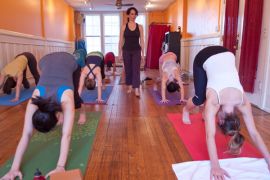Warm temperatures of summer may seem like a distant hope, but every week students like senior Lena Yue come in contact with temperatures reaching 105 degrees Fahrenheit.

Yue is one of the many students participating in a new trend in exercise: hot yoga. While traditional yoga is known for it’s slow pace and mindful relaxation, hot yoga is peaking in popularity thanks to the added benefits of working out in heat: burning fat more effectively, sweating out toxins and improving flexibility.
“Yoga has [become] a new, popular way to exercise in the last couple of years,” Yue said. “I don’t really like slow exercise, so heated power yoga was a great replacement for a gym workout.”
Set at temperatures from 80 to 105 degrees Fahrenheit, hot yoga rooms allow people to indulge the mind, body and sweat glands for a heated hour or more.
Tory Jenis, owner of Blackbird Studio in Ithaca, said the reason she uses heat in her power yoga classes is because it gives participants an intense stretch.
“Heat allows you to get a deeper stretch in the muscles, and the muscles relax a lot faster than if you’re not in heat,” she said. “It’s also a more challenging workout with a better sweat. You get your heart rate going faster than in yoga without heat.”
Hot yoga is different than its counterpart style Bikram yoga. Bikram yoga is a series of 26 specific sequential postures performed in a heated room, while hot yoga is a form of Hatha yoga just performed in heat.
Jenis’ advice for those starting out with hot yoga is to come to class on an empty stomach and bring enough water to drink throughout the class.
“Some people do get a little light-headed when they start doing the hot power yoga,” she said. “But the key is to use modifications or pause and go outside to cool off.”
With increased sweating comes the potential for dehydration, and with the added flexibility comes the ability to overstretch, causing pulled muscles or sprains. When stretching, ligaments can have difficultly returning to their original shape and size, leading to loose joints. Some common short-term side effects include dizziness, nausea, muscle weakness and cramping, Jenis said.
Jenis also said that yoga is a very dynamic and challenging exercise, but it is still accessible to any level practitioner.
“We talk all the time about honoring your body,” Jenis said. “You have to watch to balance between challenging yourself but being careful, especially if you’ve never done it before.”
Mighty Yoga is another studio in Ithaca that incorporates heat into their classes. Yue said she has been attending classes there up to four times a week. Owner and instructor Heather Healey, who has been doing yoga for five years, said having heat helps stretch the muscles further.
“In doing yoga in a nonheated room, I felt I didn’t get nearly as much out of it,” Healey said. “Heat makes it a lot safer to practice yoga.”
Mighty Yoga offers classes for all levels. Healey said her philosophy was to have an open-door policy for trying out yoga.
“There are a lot of people who are hesitant to try yoga because they think you have to be super thin or super flexible or really athletic,” she said. “Our classes are challenging, but you don’t have to bend yourself into a pretzel to come and get a good workout.”
On campus, the college currently offers two beginner classes and a power yoga class for students. Kathy Farley, Fitness Center administrative assistant, said it would be hard to have a hot yoga class in the Fitness Center because of the temperature requirements.
“We don’t have any control over the heat here,” she said. “If we want it warmer we have to put in a request. Under the college’s energy conservation policy, the temperature set point has to remain between 69 and 71 degrees Fahrenheit anyway. We had to beg and plead to get them just to raise it to 70 degrees Fahrenheit.”
An on-campus class would be cheaper and more accessible for many students, considering a semester pass at the college costs $45 and an unlimited month pass at Mighty Yoga costs $105. But Sarah Hawkins, Fitness Center program coordinator, said it would be hard for the Fitness Center to offer hot yoga classes.
“Over the whole day it would be difficult to make it hot enough in [the aerobics room] in the short amount of time, and then cool it back down for other types of classes to take place,” she said.
There are more than 10 yoga studios in Ithaca, but only a select number offer classes that incorporate hot yoga.
For sophomore Julia Catalano, heat was one of the reasons she chose to take a class off campus, rather than just the normal power yoga.
“I always feel so cleansed and relaxed after class from sweating so much,” she said. “I’ve certainly never sweat more in my life. At first I found that disgusting, but now I think it feels so wonderful and detoxifying.”
Senior Katie Venetsky, who is in the college’s power yoga class, said she doesn’t think the popularity of hot yoga will last.
“Hot yoga is a fad,” she said. “Yoga has been around forever, and it’s just that certain kinds of yoga are more popular at different times, like hot yoga now.”
However, Healey said that the popularity of hot yoga will continue to rise, especially if students are constantly looking for new challenges to add to their workout routines.
“Yoga in general has exploded over the past 10 years,” she said. “There are a lot more people who are willing to try it.”




